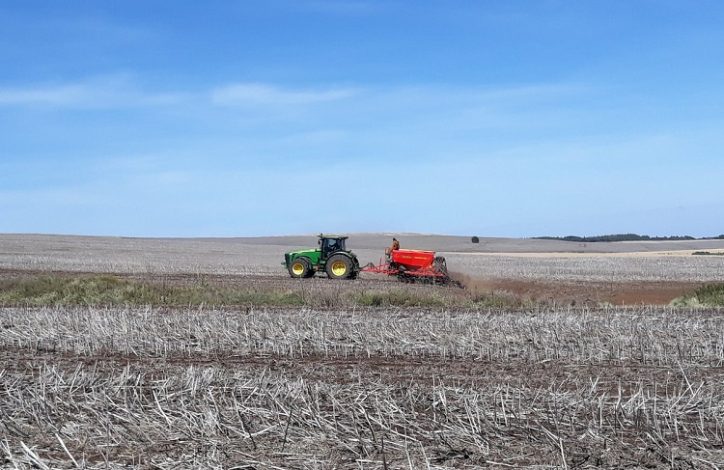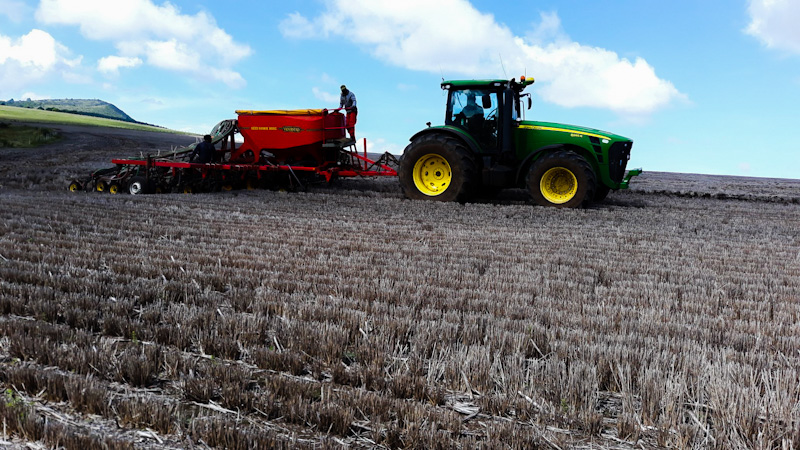Most farms—they say up to 70%—that produce everyday food crops – cabbage, carrots, onions, tomatoes, beans, green grams, and peas are small-scale.
The land holding averages 0.2–3 acres, most of which is family owned.
Crops like maize and wheat may be grown on a large scale in some parts of the country. However, most of the food produced is by smallholder farmers who farm for subsistence, only selling the surplus.
Some regions specialize in one crop type; for example, the cultivation of rice and other grains such as peas, green grams, beans, and chickpeas in mid- and lower-eastern Kenya. Farmers who specialize tend to consider land leasing options and use a commercial-oriented approach to farming. They consider the costs of their inputs versus the output value compared to the average subsistence farmer, who only sells the surplus.
At this scale of operation, mechanization is complex, and most farms utilize human labour for crop production activities like planting, weeding, and harvesting. Tractors might be used for initial ploughing and harvesters to harvest crops like rice and wheat, but scale limits access.
The use of improved seeds depends on the individual farmer. Some might get certified seeds; others may prefer seeds from previous harvests.
Overall, a lot is invested in capital, labour and time. However, with the benefit of significant economies of scale, they can maximize the returns and get the total value of their investment.
Over-Reliance on Rain as a Source of Water
They say crops do not need rain. They need water. On small-scale farms, crops are planted to coincide with the rainy seasons. But rains do fail, as they have the last few years, and with that, crops fail too.
Irrigation systems are available in some rural areas, mainly where farmers have organized themselves into groups to source and pipe water to their farms. However, these are few and far between.
Those in peri-urban areas are likely to have irrigation infrastructure guaranteeing all-year production. They tend to grow onions, tomatoes, cabbage, and leafy greens. Peri-urban farmers’ proximity to urban markets with high demand for these farm products guarantees better prices and return on investment. Thus, they are more likely to invest in irrigation infrastructure.
The Rural-Urban Divide
The majority of peri-urban farmers focus on growing food for urban dwellers. They might focus on livestock such as poultry to provide eggs and meat and indigenous vegetables with a ready market. Where a farmer is situated, their proximity to the market and the immediate food needs of that market influence the type of crops grown/livestock kept.
In rural areas, food crops serve immediate family needs, and the surplus is sold or stored. In addition, there are other food crops, including bananas, potatoes, beans, and maize, to a greater extent than peri-urban farmers. There are also poultry and vegetable but to a lesser extent than peri-urban farmers.
In rural areas, most farmers grow the same types of crops, so the surplus only sometimes has a ready market.
Thus, aggregators seeking to supply major towns with food often traverse these places, collecting produce from farmers. It is a major logistical challenge.
Buyers must travel long distances, often on poor roads, to fill up their lorry, pay cess fees across counties, and take on the risk of transporting perishable commodities. For example, avocados that ripen and spoil during transportation are discarded. The remaining fruits still have to compensate for the cost of transport. All these add up to the cost of food in urban areas.
This dual nature of smallholder agriculture poses additional challenges, such as: what market are you farming for, and what control does the farmer have over the market? Peri-urban farmers have a better grip on their markets and consumer needs. But are rural farmers the invisible party whose work is to produce while someone else dictates market prices and conditions? Is this different from the problem we have with our tea and coffee?

Farming as a Side Hustle
Farming is a side job for most small-scale farmers. The farmers are engaged in other economic activities to support themselves financially. In the rural areas, they might own a business—a small eatery or hardware shop in the shopping centre.
In peri-urban areas, they might own similar businesses or be employed at a government or private firm.
The farm is only sometimes perceived as a commercial enterprise with considerations about business expenses and revenues. They employ farm managers and labourers to manage it, often leading to “telephone farming,” with its share of mismanagement and misappropriation of resources. Splitting time between the farm and other economic activities means they cannot devote much time or even expect much from it.
Without taking the farm as a serious commercial activity worth dedicated time and investment, it is no wonder resources are poured in without matching outputs to show for it. But can they live on farm incomes of a small-scale enterprise only? Probably not.
Ways to Improve Smallholder Farmer’s Produce and Earnings in Kenya
Transportation and Agricultural Logistics – The Middlemen
As implied above, transportation is a challenge for most small-scale farmers. I have tweeted before about the prerequisites of getting into farming: first, having access to an almost free-to-use– van/lorry/pickup for transportation.
The means of transport factor in two ways:
Taking your farm produce to the market by yourself can mean a difference in the profit made off the produce. Without this, this is where the middlemen or brokers come in. They swarm at individual farmers’ farms, dictating the quantities they want and the prices they prefer. Without alternatives and staring at already-spoiling produce, farmers sell their produce at giveaway prices.
Access to means of transportation gives you some alternatives. While taking the produce to the market is not always a viable option – remember farmers have other things to do – it is still an option when you have transport. Peri-urban farmers have found a way around this – loading up produce in their cars and selling it in the evenings.
The means of transport also make a difference when the other option is to hire. Hiring farm transport can get expensive, especially with the high cost of fuel. This means it increases the cost of operations, eating up the already marginal profits. Privately owned or shared means of transportation among small-scale farmers can minimize costs and maximize profits.
At a small scale, it is imperative to consider the costs of operations as they can rack up fast, turning losses every year. This has discouraged plenty of farmers.
And despair and hopelessness are common among farmers today. How long can you put in the effort every day and still have failed crops and losses every year?
But without a say in the transport and marketing aspects of their produce, farmers will always be at the mercy of brokers.
The Agrovet Model of Farmer Education
When rural or peri-urban small-scale farmers need information about a particular pest on their crops or livestock, they approach the local Agrovet, who then advises them on which product to buy and apply. The agro-vet is king in these types of contexts. They not only supply products but vital information regarding pest and disease control, crop and livestock management, and productivity.
With the breakdown of public-funded extension services, farmers adopt a product-first approach to addressing pest or disease problems. This is not only expensive but also potentially harmful to the farmer, the produce, and the environment.
With profit incentives in mind, the Agrovet may not always guide the farmer appropriately in the use of pesticides. They might recommend their products even where a more conservative approach is sufficient.
Without proper guidance on use, disposal, and safety, the result is farm produce with higher than recommended levels of pesticide residues, chemically damaged soils and other consequences for beneficial insects and other members of the farm ecosystem.

Traceability and Food Safety Monitoring
As described above, smallholder farming is too fragmented, with consequences for food safety. It is almost impossible to monitor the produce from each farm – the number of pesticide residues, storage conditions, and post-harvest processes that affect food quality and safety.
When government agencies monitor food safety, they do it at the market level, after it has been aggregated and sold to retailers. It is difficult to trace produce back to the farm it originated from. The alternative, self-regulation, would be too high an expectation for individual farmers.
On Twitter, we have regular discussions on food safety. I often say trying to “eat healthily” can cause more harm than good. You try to add more leafy greens; they are contaminated with factory/sewage waste. Add more fruits? They have high pesticide residues. More nuts and grains, there’s probably aflatoxin waiting for you.
Large retailers can bypass the fragmented nature of small-scale agriculture and source from farmers directly. This way, they have better control over quality and safety, but at a premium price.
Inequalities such as these can cause harm because you not only have to buy the food, but you also have to pay extra for its safety/quality.
Is there a way out?
I believe small-scale agriculture as it is now is too impractical to be profitable. The costs of production and operations are high and a lot of the production aspects are still outside a farmer’s control.
Huge investments are made in terms of labour, money, and time without outputs to show for them. Unless a farmer is growing food for their personal use, there should be more deliberate efforts to enhance production, minimize costs, and ensure the safety of the produce.
As it is, small-scale agriculture would be difficult to reform. But there is a way—to simulate large-scale operations in small-scale settings.
How?
Christine Gatwiri, Writer, Researcher. With Interests in Food Systems, Food Anthropology, Water Scarcity and Dryland Agriculture. This article is republished from The Farming Food Newsletter under a Creative Commons license. Read the original article.




